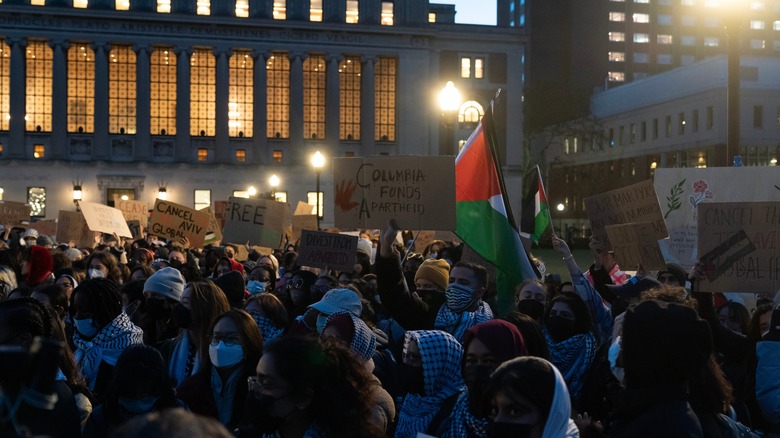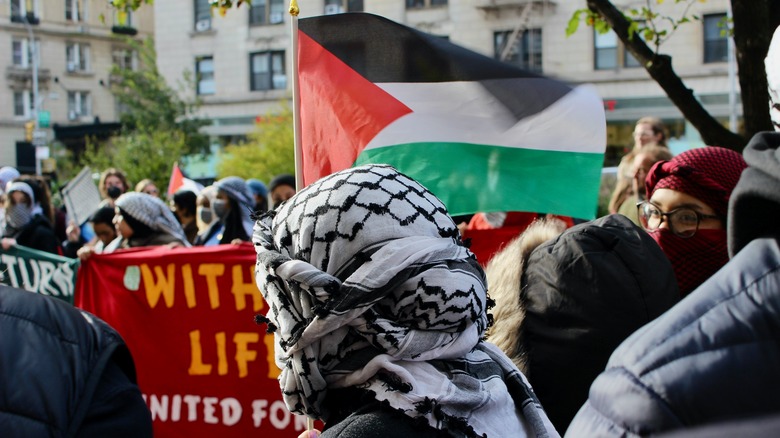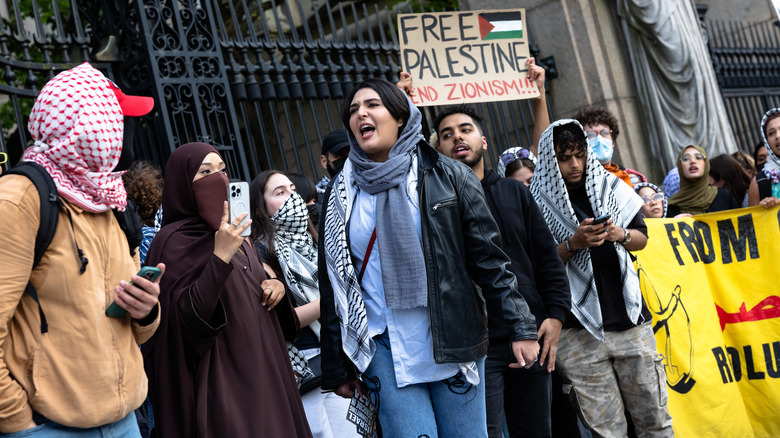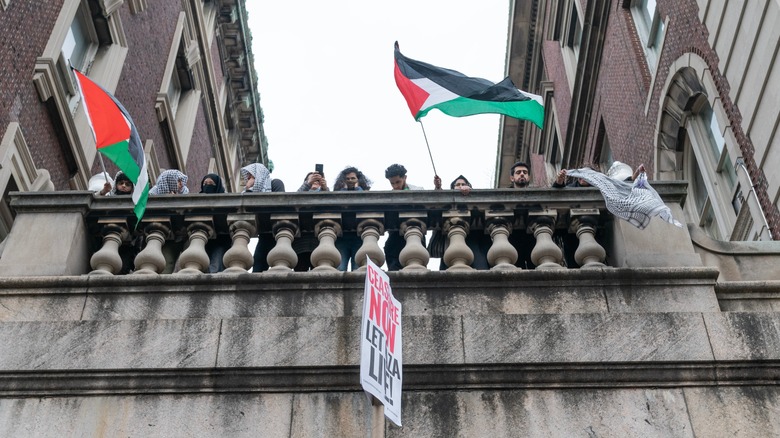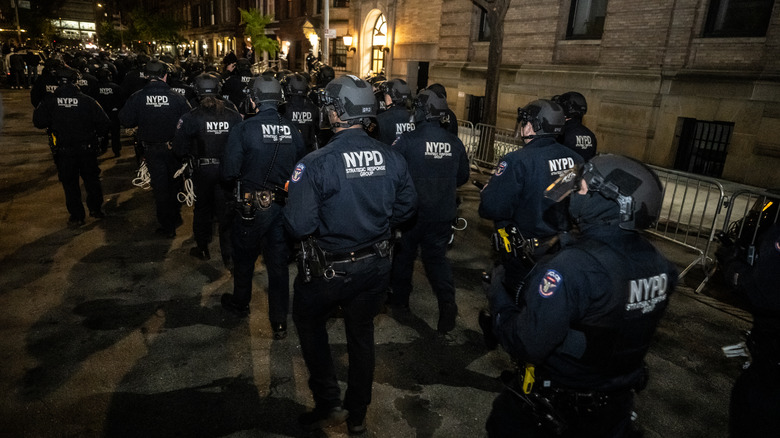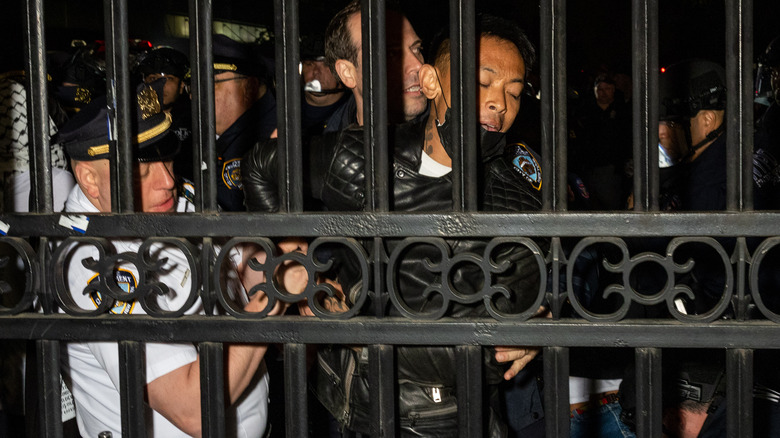The Timeline Of The Columbia University Protests Explained So Far
Tempers have run high ever since ongoing hostilities between Israel and the Palestinian terrorist organization Hamas broke out into open conflict on October 7, 2023. Citing a recent study by Morning Consult, Time magazine states that global opinion about Israel's response to Hamas' attacks has all but universally nosedived. South Africa has even filed a case against Israel at the International Criminal Court in The Hague for "genocidal acts" conducted against Palestinians living in the Hamas hotbed of Gaza, as Time outlines.
Protests against Israel and in support of Palestine — and sometimes even in support of Hamas — have cropped up around the globe. This is especially true in the far-flung United States, a nation very historically supportive of the Jewish state of Israel. Pew Research polls, however, show dramatic divides amongst the American public regarding the Israel-Hamas conflict, particularly across lines of age and political party affiliations. Seventy percent of Republican voters, for instance, stated that they side with Israel, and only 25% of Democratic voters. Younger ages, in general, show more uncertainty in their opinions. But overall, younger people — specifically those aged 18 to 29 — view Palestine more sympathetically than Israel.
And so, protests have cropped up across at universities across the country. These protests have led to student arrests at a staggering 30 universities across 24 states at the time of writing, as CNN reports. But it's Columbia University in New York City that's proven the most volatile protest location, to the point where hundreds of students have been arrested.
Columbia's precedent of protest
In a very real sense, the current rash of protests at Columbia University has roots decades deep. In answering the questions, "Why Columbia?" and "Why are its protests so explosive?" we've got to tour Columbia's politically charged history. As the Associated Press says, Columbia students are very keyed into this aspect of their university's "lore."
As Time outlines, Columbia University became a nucleus of anti-war sentiment during the Vietnam War. Come 1968, the NYPD was called to the campus to do exactly what they did in late April 2024: clear students out and make arrests. Back in the '60s, such pushback had the unintended consequence of "radicalizing" students who otherwise had little interest in events.
The same pattern repeated in the 1980s during protests against South African apartheid. Back then, as Vox explains, Columbia students wanted "divestment" from South Africa, meaning that they wanted an official university separation from businesses connected to the nation and its government. Students involved in the recent Gaza-centered protests have called for the same divestment from Israel.
This time around, things started coming to a head months ago. In February, Columbia University suspended the university's student chapters of Justice in Palestine and Jewish Voice for Peace, which further drove students to protest. That same month, the university — perhaps seeing what was coming — delineated official "demonstration areas" for students, per the Columbia Spectator. It also updated its disciplinary procedures for students in violation of event policies. In short, Columbia's current protests have been long, and short, in the making.
Columbia protestors gather on campus
In the immediate term, pro-Palestine (or anti-Israel) protests at Columbia University ratcheted up in the middle of April, 2024. On April 17, Columbia students in the hundreds congregated in the middle of their campus and pitched tents. It's unclear exactly what they were intending to accomplish besides the aforementioned divestment of Columbia from financial ties to Israel. Perhaps Professor at Fordham University Mark Naison articulated it best without realizing it, saying proudly on the Associated Press, "Whenever there is a movement, you know Columbia is going to be right there."
On the same day that Columbia's students set up camp, university president Nemat Shafik sat before Congress accused of not doing enough to condemn antisemitism at Columbia that had arisen in the midst of growing pro-Palestine sentiment. The following day, on April 18, the NYPD swarmed the university at Shafik's request and arrested over 100 protestors. Much like other the 1960's and 1980's shutdowns described earlier in this article, intervention by authorities created a ripple effect across other campuses in the United States. The University of Michigan, the University of North Carolina, the Massachusetts Institute of Technology, and more quickly followed suits with their own pro-Palestine encampments.
For Shafik's part, she drew criticism from academic circles who said she'd "undermined academic freedom and ignored privacy and due process," per The Guardian. That same article quoted Biden administration's John Kirby, who said the protests were "absolutely the wrong approach." As of May 2, The Guardian reported that President Biden said the demonstrations will not affect his policies regarding Israel.
Columbia moves classes online
Tensions at Columbia University didn't exactly dwindle in the days following the NYPD's arrival. Amidst an increasingly polarized environment, Jewish students said that they didn't "feel safe," as NPR states. In response, Columbia president Nemat Shafik ordered that classes be held online starting Monday, April 22, "to deescalate the rancor and give us all a chance to consider next steps," as Al Jazeera quotes. Shafik also said, "We cannot have one group dictate terms and attempt to disrupt important milestones like graduation to advance their point of view."
In the meantime, a new round of protestors had settled into the grounds of Columbia University. Two days after shifting to online classes, the university set a deadline for these new protestors to clear out by midnight, April 24. Some did, but others stayed behind and continued to push for their university's divestment of financial ties to Israel.
On April 26 the protestors said that they'd "reached an impasse with administrators," as the Associated Press writes. Students of all levels of degrees — including doctoral students — also wanted "more transparent financial disclosures" from Columbia. To this, university representative Ben Chang simply said, "We have our demands; they have theirs," and also reiterated the university's commitment to an "ongoing dialogue." For his part, Professor Ege Yumusak said, "The faculty have completely lost confidence in President Shafik's ability to lead this organization." Meanwhile, similar patterns of pro-Palestine university encampments, protests, and arrests repeated themselves across the country.
Suspensions and occupying Hamilton Hall
By April 29, Columbia suspended protesting, encamped students who didn't adhere to a 2 p.m. deadline that day. Like before, some left and some stayed. Those who stayed even took some of the green carpeting reserved for graduation and laid it on the grounds of their tent encampment as flooring. That graduation, it should be noted, is scheduled for May 15.
At the same time, protesting students begin calling for "amnesty" regarding suspensions, tuition, grades, legal charges, you name it. As the Associated Press explains, some students have already faced consequences besides getting arrested during the NYPD's first round at campus, like 50 students from Columbia's Barnard College who got evicted from their housing. A mere 10 days later on April 28 "nearly all" had been allowed back.
On April 30, the day after suspensions went into effect, protestors occupied Hamilton Hall and barred entryways into the building. They hung a "Free Palestine" banner and continued asserting their demands for financial divestment of Columbia from Israel, as well as their additional demands for increased financial transparency from the university.
Columbia warned the protesting students that they had to clear out or be expelled. They didn't, and within hours the NYPD swept through equipped with riot gear, gas masks, and shields. Video footage from outlets such as WTVR CBS 6 shows a degree of orderliness when police start stepping through tents. Things get ugly quickly, though, and many protestors devolve into a shouting, rampaging, brawling mass who are forcibly restrained or moved.
Riot police and mass arrests
By Wednesday, May 1, NYPD had arrested 109 people at Columbia University, although it's unknown how many of these are students. The police also cleared out Columbia's protest encampment. New York Mayor Eric Adams didn't pull any punches about police action, saying, "There is a movement to radicalize young people, and I'm not going to wait until it's done and all of a sudden acknowledge the existence of it," via CBS. He added, "We're proud to say they [radicalizers] have been removed from the campus." For her part, Columbia University president Nemat Shafik said she was "sorry we reached this point."
Naturally, students and other groups remain divided on whether or not Columbia should have called in the police — again. On one hand, Barnard sophomore Lily Zuckerman told CBS that if the university cracked down hard enough on the first encampment, then the second round of NYPD arrests wouldn't have had to happen. New York's Council on American-Islamic Relations contrarily said, "It is sad but not surprising that Columbia University ... would rather unleash the NYPD on their own students than simply meet their demand to divest from the Israeli government and its genocide in Gaza." Arrested protestors, meanwhile, were met with cheering, music, and food from supporters when they stepped out from One Police Plaza after a night in jail.
At present, Columbia University is waiting until "disciplinary hearings" to decide the fate of protestor graduations, grades, suspensions, and such, per the Associated Press.
